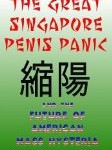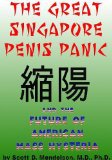Five words from the blurb: Singapore, terrified, penis, psychiatric, hysteria
Every year The Bookseller award The Diagram Prize for the oddest book title of the year. I always enjoy looking at the shortlist, but normally just marvel at the variety of bizarre books out there. This year one title on the shortlist stood out and I was intrigued enough to try a sample chapter on my kindle. The introduction left me keen to understand why hundreds of men from Singapore thought their penises were shrinking, so I bought a copy.
In 1967 an outbreak of Koro occurred in Singapore. Koro is a frightening condition in which sufferers believe their penises are retracting.
Most often the men arrived at the hospital in a state of panic with their hand, or the hand of a loved one, firmly gripping their penis to prevent it from withdrawing up into the abdomen and killing them. Others came with their penis tightly anchored with ribbon or string.
The condition originates from Chinese folklore and isolated incidents are not uncommon, but it is unusual for so many people to succumb at once. The exact cause of this outbreak cannot be linked to a single event, but a combination of factors joined together to produce this strange reaction. The book describes the history of Singapore and all the important global events that resulted in “penis panic”.
The book goes on to describe similar conditions that arise in other countries around the world and it explains how cultural background has a strong influence on the nature of the problems experienced. Almost all of the conditions were new to me, but there was also a section on America and I was surprised to see that conditions like bulimia are specific to American society, or countries strongly influenced by it.
Unfortunately the book focused on things from a scientific perspective, noting the number of people affected on any given day and the extent of the epidemic. I longed for more personal stories and for some insight into what causes an individual to fear for their life, despite there being no real danger. I’d have prefered to read details about the situation in the hospital waiting rooms, rather than just the briefest details of which drugs the patients were given.
I also found the writing to be nothing special – it could have benefited from some editing as the same few facts were often repeated.
Despite these problems I’m pleased I read this book. It was fascinating to learn about the cultural influences on medical conditions and this final warning was particularly pertinent.
Absurd and dangerous culture bound notions are ever evolving in the United States. The use of the Internet and other lightening fast forms of social media and communication appears to be accelerating this process. There is not the slightest basis for Americans to be smug or condescending in their view of the culture bound syndromes of other societies, including Koro and the Singapore Penis Panic of 1967. In America, the next culture bound epidemic is a mouse click away.
Recommended to anyone interested in the origins of mass hysteria.

.

